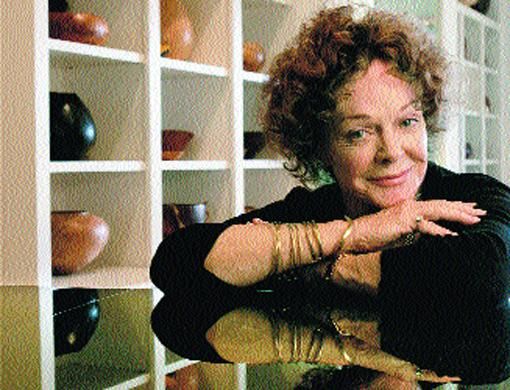Ann Ehringer is a modernist at heart, but today in her sleek Santa Monica living room in the US, she is holding a link to ancient history.
In her cupped hands is a small wood bowl.
Behind her, displayed like fine china on glistening white shelves, are 150 other hand-turned vessels.
Each was sculpted out of chunks of exotic wood: white sycamore from Ireland, cinnamon-coloured erable from Canada and deep koa from Hawaii.
Some are smooth with a shiny polish; others are rough.
One made of rich maple burl has a ragged top and walnut strips that act as stitches across a gaping hole.
Naturally wonderful
“The bowls represent what is absolutely natural: wood, grown and aged,'' Ehringer says.
“Sometimes there are holes where there were knots. To turn a bowl with less than perfect wood is an art. To get it to expose its flaws without breaking its thinness is a wonderful act to witness.''
Some of her bowls are as small as a silver dollar with sides as thin as a dime's.
Others are large enough to hold a family meal or conceal a possession.
Ehringer, a businesswoman who owns the Saddle Peak Lodge restaurant in the mountains above Malibu, US, bought her first hand-turned bowl in 1959 in Kauai.
Years later, while visiting New Zealand, she saw another exquisite bowl.
Although she did not buy it, “it ignited something in me'', she says. “I thought later, ‘the next time'.''
Since then, whenever she travels, she looks to add one more to her collection.
Her latest find, from the Hawaiian island of Molokai, is a foot-wide pale Norfolk pine with knotholes forming a smiley face.
A few of her bowls were sculpted from wood that was still green; over the years, as the wood shrunk, their openings changed from perfect circles to ovals and oblongs, which adds to their appeal.
“They are wonderful to look at and touch. I feel an elemental connection with the wood,'' Ehringer says, running a finger around the lip of an asymmetrical bowl.
Jan Peters, who has been selling artistic woodwork for more than 20 years at del Mano Gallery in Brentwood, says: “There is a natural human response to wood and we intrinsically understand it. A vessel speaks clearly by its simple beauty. A good artist brings that to light without overshadowing it.''
Peters, whose gallery has wood pieces by artists from 12 countries, says collectors today evaluate the way a wood turner exposed the inherent qualities of the grain and embellished the surface.
Bowls by new artists, she says, can start at $200 (Dh734); work by master wood turner William Hunter of Rancho Palos Verdes, California, are priced at $35,000 (Dh128,500) and for works by Mark Lindquist of Quincy, Florida, prices rise upto $100,000 (Dh367,130).
Increasing popularity
Peters says the popularity of collecting hand-turned bowls has increased since the mid-1980s, when the Smithsonian's Renwick Gallery exhibited some of collector Edward Jacobson's holdings.
The Art of Turned-Wood Bowls show and the book based on it resonated with people.
Ehringer prizes her collection so much that she designed her interior to showcase the bowls.
Her home is white, modern, spare and comfortable, with deep-cushioned sofas, chrome-frame chairs and glass tables.
Holds a centre place
“I don't have wood-framed furniture,'' she says.
“That was a conscious choice not to take away from the beauty of these special objects. These bowls are the centrepiece of my house.''
She speaks poetically about the bowls, reaching out to them.
“There is something about them that reminds me that I really believe in long-term relationships,'' Ehringer says.
“The bowls go on and on. I have had some longer than I've had my two grown children. They will outlast us all.''
On the shelf
- Types of wood one can find on Ehringer's shelves are: avocado, banyan and camphor, among many others.
- Most of Ehringer's collection comes from Hawaii. Calabash bowls are inspired by the bulbous shape of gourds.
- These feast bowls (calabash) once hollowed out with sharp stones and coral were reserved for Hawaiian royalty until 1819. They were named after a chief or ancestor and passed on through generations. Sometimes, a child is named after the bowl and is responsible for life to care for it.
- Ehringer's collection includes works by Hawaiians Dan DeLuz and Jack Ewing. Many were gifts, such as the banana-shaped bowl made from a kiawe tree.
- Ehringer has 35 bowls — made from monkey pod, kamani, koa and tamarind — by DeLuz, who lives in the Big Island.













